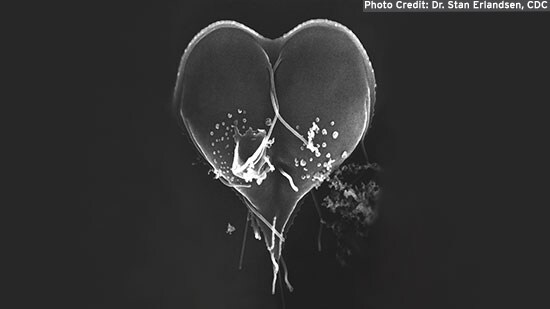
Giardia
What is Giardia?
Giardia duodenalis (or Giardia lamblia or Giardia intestinalis) is a single celled animal, i.e., a protozoan, that moves with the aid of several flagella. It is sometimes referred to as Lamblia intestinalis. It is the causative agent of giardiasis, an infection of the small intestine and the most frequent cause of nonbacterial diarrhea in North America. The World Health Organization (WHO) estimates roughly that 200 million people worldwide are infected with Giardia annually.1
WHAT ARE THE SYMPTOMS?
Consumption of just one cyst can cause disease, though the level of infectivity will vary among infected individuals and Giardia strains. The organism may exist in an actively reproducing form (trophozoite) or in a resting state or cyst. The cyst form has the ability to infect humans from environmental sources.
Giardia infection (giardiasis) can cause a variety of intestinal symptoms that begin one to two weeks after ingestion of cysts and frequently recur. These include diarrhea, gas or flatulence, greasy stools that tend to float, stomach cramps and upset stomach or nausea, which may lead to weight loss and dehydration. Some people with giardiasis have no symptoms at all. In otherwise healthy persons, symptoms of giardiasis may last two to six weeks.
HOW IS IT TRANSMITTED?
Giardiasis is most frequently associated with the consumption of contaminated water. It has been found in the intestinal tracts of some animals (dogs, cats, beavers and bears) and some outbreaks may be attributed to infected food handlers or raw vegetables.
Once an animal or person has been infected with Giardia, the parasite lives in the intestine and is passed in the stool. Because the parasite is protected by an outer shell, it can survive in the environment outside the body for long periods of time.
HOW IS IT CONTROLLED?
Key for control of Giardia is control of the water supply that may be contaminated, including untreated water from shallow wells, lakes, rivers, springs, ponds, streams or any recreational water. Ice can also be contaminated if prepared from a contaminated source. Water can be treated via heating to a rolling boil for at least one minute or filtering through a filter that has an absolute pore size of at least one micron or has been NSF rated for “cyst removal.” According to the EPA, “Chlorine is generally more effective than iodine in controlling Giardia, and both disinfectants work much better in warm water.”2 However, relatively high chlorine levels and contact times are required, and the combined effects of temperature, pH and chlorine demand all need to be considered when developing an effective treatment.3
Other controls include effective handwashing and excluding ill individuals from handling food.
For assistance with this topic or other food safety questions for your operation, please Contact Us.
REFERENCES AND FURTHER INFORMATION
- FDA
- CDC
- FAO
- Erickson, M.C. and Ortega, Y. R. 2006. Inactivation of Protozoan Parasites in Food, Water and Environmental Systems. Journal of Food Protection. 69(11): 2786-2808.
1Global Health Situation and Projections Estimates
2EPA - Safewater
3Jarroll, et. Al. 1981. Effect of Chlorine on Giardia lamblia Cyst Viability. Appl. Environ Microbiology 41(2): 483–487.


